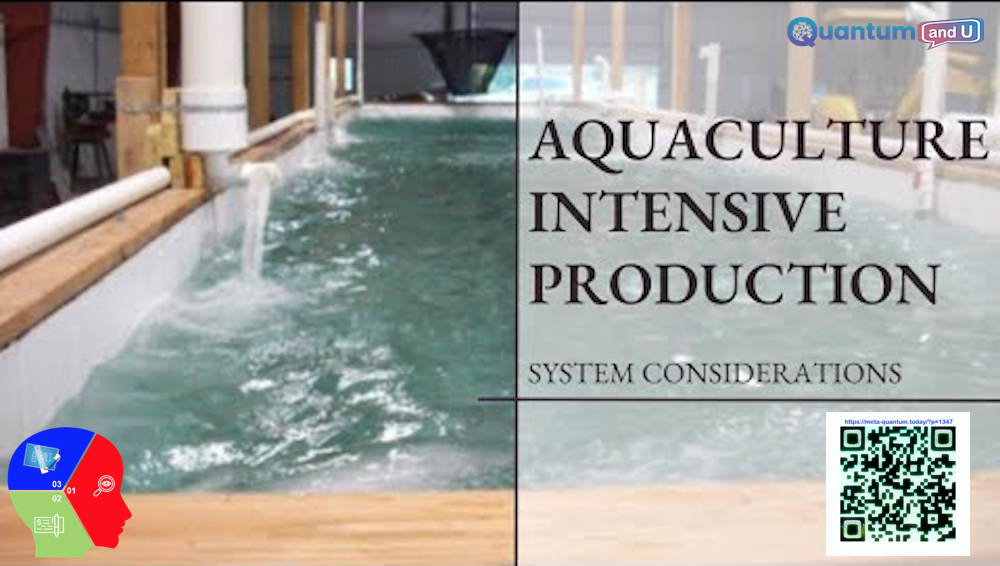
Introduction:
The video begins with the presenter providing a comprehensive introduction to the concept of intensive aquaculture. He elaborates on how farmers in Missouri and the Midwest region have shown a growing interest in embracing these advanced technologies. By adopting these technologies, farmers aim to enhance their farm production and generate higher income. The presenter highlights the significant expansion of the aquaculture industry over the past few decades, underscoring its pivotal role in supplying nearly half of the world’s seafood. This clearly demonstrates the escalating significance and influence of aquaculture in addressing the ever-increasing global demand for seafood.
Intensive aquaculture:
Intensive aquaculture is a system of farming aquatic organisms in which high stocking densities and high levels of inputs are used to maximize production. This includes things like artificial feeds, aeration systems, and environmental controls. Intensive aquaculture is often practiced in artificial structures such as tanks, raceways, and cages.
Market size for intensive aquaculture in Southeast Asia
The market size for intensive aquaculture in Southeast Asia is large and growing. In 2021, the value of the aquaculture market in Southeast Asia was estimated to be US$42.9 billion. Of this, intensive aquaculture accounted for approximately 60%, or US$25.7 billion.
The growth of intensive aquaculture in Southeast Asia is being driven by a number of factors, including:
- Increasing demand for seafood: The demand for seafood in Southeast Asia is increasing rapidly, due to population growth and rising incomes.
- Limited wild fish stocks: The wild fish stocks in Southeast Asia are overfished, and cannot meet the growing demand for seafood.
- Government support: Governments in Southeast Asia are supporting the development of intensive aquaculture, in order to increase seafood production and create jobs.
The main types of intensive aquaculture practiced in Southeast Asia are:
- Shrimp farming: Shrimp is the most important aquaculture product in Southeast Asia, accounting for over 70% of production. Shrimp is typically farmed in ponds or tanks, using artificial feed and aeration systems.
- Fish farming: Fish farming is also a major industry in Southeast Asia, with the main species farmed being tilapia, catfish, and carp. Fish are typically farmed in ponds, cages, or raceways.
- Mollusc farming: Mollusc farming is growing in importance in Southeast Asia, with the main species farmed being mussels, oysters, and clams. Molluscs are typically farmed in coastal areas, using artificial structures such as ropes and rafts.
The main export markets for intensive aquaculture products from Southeast Asia are the United States, China, Japan, and the European Union.
Challenges
Despite the growth of intensive aquaculture in Southeast Asia, there are a number of challenges that need to be addressed, including:
- Environmental concerns: Intensive aquaculture can have a number of negative environmental impacts, such as pollution from uneaten feed and feces, and the spread of diseases.
- Animal welfare concerns: Intensive aquaculture systems can often lead to poor animal welfare conditions for the fish and other aquatic organisms that are being raised.
- High costs: Intensive aquaculture systems can be expensive to set up and operate. This is due to the high levels of inputs that are required.
Related Sections:
- Evolution of Aquaculture:
- The presenter traces the history of aquaculture, noting that in the 1960s, pond production typically yielded 1,000 to 2,000 pounds per acre. Today, super-intensity systems can achieve up to 45,000 pounds per acre.
- Differentiates between indoor and outdoor aquaculture systems.
- Partitioned Aquaculture and Split Ponds:
- Discusses the development of partitioned aquaculture systems and the cost-effective approach of Mississippi split ponds.
- Emphasizes the differences in algae control and waste treatment in these systems.
- Intensive Ponds and Aeration:
- Explains the concept of intensive ponds with high aeration rates, leading to the rapid growth of cyanobacteria or blue-green algae.
- Highlights the contrast in algae growth between conventional ponds, intensive ponds, and split ponds.
- In-Pond Raceways and Cost Analysis:
- Mentions in-pond raceways as another system, with cost analysis comparing different technologies.
- Presents data on production levels and costs for different aquaculture systems.
- Challenges for Midwest Aquaculture:
- Addresses the challenges of applying these technologies in the Midwest, where temperature conditions differ from the South.
- Estimates higher costs due to longer grow-out periods and lower fish densities.
- Personal Experience:
- Shares the speaker’s personal experience with setting up a zero-discharge, temperature-controlled recirculating aquaculture system in Missouri.
- Details the construction costs and various systems tested, highlighting the advantages and disadvantages of different containment methods.
- Economics and Profitability:
- Discusses the economics of producing fish or shrimp in recirculating aquaculture systems.
- Stresses the importance of considering retail sales to make these systems profitable and compete with traditional pond-based aquaculture.
- Conclusion and Takeaways:
- Advises starting small and evaluating markets before investing in technology.
- Highlights the potential for higher-quality fingerlings in partitioned aquaculture systems.
Conclusion: The video concludes by emphasizing that while recirculating aquaculture systems (RAS) may not compete with traditional pond systems on cost alone, there’s potential for profitability through direct retail sales. The presenter suggests that interested parties should carefully consider market dynamics, water and feed management, and the importance of starting small to navigate the challenges of intensive aquaculture effectively.
Key Takeaways:
- Intensive aquaculture technologies have significantly increased fish production per acre over the past few decades.
- Different systems, such as partitioned aquaculture, split ponds, intensive ponds, and in-pond raceways, offer various advantages and cost considerations.
- Applying these technologies in the Midwest may present challenges due to different temperature conditions, potentially leading to higher production costs.
- Profitability in intensive aquaculture often depends on direct retail sales and considering the entire supply chain.
Reference(s):
Aquaculture development and sustainability in Southeast Asia


